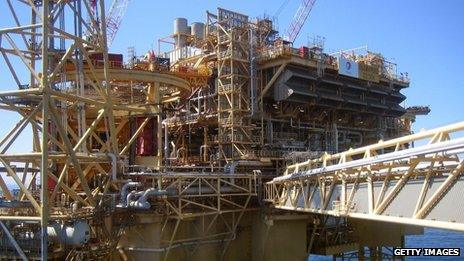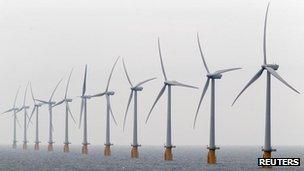Drills, spills and thrills
- Published

The North Sea will continue to be a busy place
As it's almost all over the horizon and much of it under the seabed, it's easy to ignore the bonanza in offshore energy.
The subsea sector of the oil and gas industry has been trying to put legislators right on that today, presenting them with a report on the scale of what they're up to where the sun don't shine.
And while other commodity prices have been falling recently, they're helped by the resilience of the oil price - holding up above $100 per barrel, and helped to stay there by Middle East tensions.
With annual turnover at £8.9bn, and with nearly 50% growth in the past three years, Britain's subsea sector is claiming 16,000 jobs have been created in the industry during that time, adding to 53,000 jobs already in it.
That means the UK is reckoned to have 45% of the £20 billion global market. North-east Scotland accounts for three-quarters of that activity, across manufacturing, engineering, construction and diving. And it accounts for much of the 43% of activity getting exported.
It's just one of the market updates on the offshore industry that suggests prospects are going to remain rosy for a while yet.
Life begins at 40
Wood Mackenzie, the industry consultancy based in Edinburgh, recently said there's £44bn of investment coming the way of UK waters in the next five years. For various reasons, the level of investment is going through a particularly lively stage just now, with a production boost to follow.
Wood Mac points out it hasn't looked this busy since the 1970s. "Maybe life does begin at 40," the industry experts observed.
Not all that investment is going into the UK supply chain. On Wednesday, we learned the huge Mariner heavy oil field, east of Shetland is to have much of its topside engineering and construction done by Norwegian firm Aker in Norway, Germany and Korea.
Going deep
The UK, having lost much of its fabrication capacity, is also missing out on big opportunities to build new rigs for the boom under way in deep sea drilling globally. But Aberdeen has other expertise that should keep it a major centre for supplying drillers.
Last week, Wood Mac followed up its UK analysis with a survey of deepwater markets following the Macondo blow-out and spill in the Gulf of Mexico.
That tragedy didn't slow things up by much. While international oil companies find access to big reserves in conventional places is being protected ever more by nationalised companies, they are looking to new frontiers to keep up their resources.
Deepsea drilling activity worldwide returned to pre-Macondo levels last year, and the consultancy forecast bullish growth, rising from US$43bn to $114bn in 2022.
The number of exploration, appraisal, and development wells will increase from 500 to 1,250 wells per year, says Wood Mac.
There are clearly challenges from the technology, the financing and safety, but it's at least as challenging to keep up with that level of growth.
For instance, it's calculated that 95 new deepwater rigs will have to be built between 2016 and 2022, representing $65bn of investment. Allied to existing orders, 37,000 more offshore workers will be needed.
Ruling the waves
Environmentalists will despair at this level of activity. They'd prefer to keep oil and gas under the seabed rather than burn it or risk spilling it.
But there's the offshore renewables bonanza to consider as well. The subsea oil and gas sector points out that it's only a small part of what it's doing out of Aberdeen so far.

Much of the offshore wind development has been around the English coast
From another energy consultancy, Douglas-Westwood, comes a projection of how much work there could be over the next 10 years from offshore wind power.
There are plans for an average 3.2 gigawatts of power to be put in place each year over the next 10 years (more than half Scotland's needs), with the spend peaking above £16bn in 2016.
It notes in its fifth annual market forecast that the UK has been driving much of this, mostly off the English coast. Germany has too.
But there are significant obstacles still in place, not least the high cost of making this happen, and the appetite of either governments or consumers (electricity bill-payers, that is) to provide the necessary subsidies.
Moreover, Douglas-Westwood warns that there's a lack of the necessary finance to get things really motoring.
"The current dependence on global utilities to self-fund projects is unsustainable in the long-run, leading to a potential funding gap in the future," he says.
That funding gap on a commercially unproven wave power technology, from Pelamis, is even more of a concern. E.On was such a global utility that this week pulled out of its partnership with the Edinburgh firm.
With the can-do attitude of the oil and gas sector, it may be that these energy giants are going to have to be the ones that provide both the technology and the finance to make renewables work, and pay.